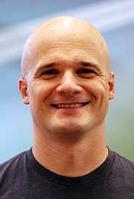IE PhD student to be a “MartianMaker”
IE PhD student Denys Bulikhov (Landry Lab) will serve as the executive officer of the multidisciplinary Purdue MartianMakers team. The Purdue Mars Activities and Research Society (MARS) selected the team to operate the Mars Desert Research Station (MDRS) in Utah from Dec. 30-Jan. 12. The mission's purpose is to improve technical expertise and knowledge in preparation for future travel to Mars.
The team will work on a number of experiments and research projects. Bulikhov will conduct research on:
- “How stress experienced during simulated Extravehicular Activity (EVA) affects decision making of an astronaut” - Extravehicular activity is an extremely demanding task, physically and psychologically. EVA exposes astronauts to significant physiological stress. Multiple studies have shown that human decision making is strongly influenced by stress. It has been demonstrated that stress changes a participant's attitude towards risk which in the case of EVA may lead to dangerous consequences. This particular study is designed to investigate the possible influence of physiological stress experienced by participants during simulated planetary EVA on their decision making.
- "Radiological mapping of MDRS and surrounding areas" - Measurement of alpha, beta and gamma radiation around the MDRS habitat at various locations in order to simulate the creation of a radiation map on Mars (with Nuclear Engineering).
Bulikhov feels that his IE training will benefit the mission. "I got really interested in theoretical and practical approaches to decision making after taking related IE classes with Dr. [Mark] Lehto," he said. "I would like to combine this interest with my passion towards space and human factors."
The simulation includes a variety of aspects that combine to make the experience as real as possible. The team cannot break simulation during the mission and must don a flight suit and a heavy air pack with helmet every time they perform extra-vehicular activities. Highly structured daily schedules are used and the team must work with extremely limited amounts of water, power and communication.
Source: "Living on Mars: Purdue team to lead simulation facility mission", by Brian Huchel, Purdue News (Dec. 12, 2018).
Video: "MartianMakers"


